Microsoft CEO Talks AI, Security, Teams, Azure At Ignite 2022
‘Azure is the only cloud that supports all organizations and all workloads, from enterprises to startups to highly regulated industries,’ Microsoft CEO Satya Nadella says in his Ignite keynote this week.
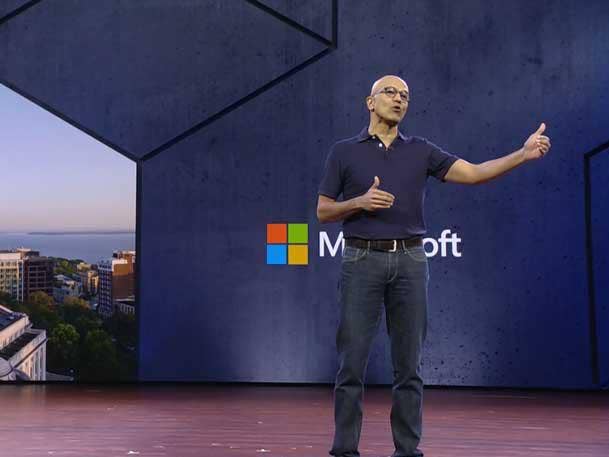
Without naming names, Microsoft CEO Satya Nadella used his Ignite 2022 keynote address to tout the tech giant’s cloud offerings as better than competitors, with “more cost effective” data, enterprise applications and cybersecurity capabilities, recommending against users cobbling together a series of third-party services.
“Moving to Azure enables cost and operational efficiencies, and we want to help you leverage these savings to accelerate your own innovation,” Nadella said this week. “Azure is the only cloud that supports all organizations and all workloads, from enterprises to startups to highly regulated industries. Azure is the world‘s computer.”
Microsoft held Ignite 2022 online this week with a small in-person element. The company used the event to unveil innovations around security – including a new Defender for DevOps offering – and the Teams collaboration application that has opened up major opportunities for partners, with customers even enlisting Teams as a phone system and demanding Teams-enabled hardware for conference rooms.
[RELATED: Microsoft Ignite 2022: Top Security Announcements]
What did Microsoft CEO Satya Nadella say at Ignite 2022?
Nadella’s warnings against users cobbling together third-party offerings instead of using products from Microsoft comes as rivals such as CrowdStrike CEO George Kurtz continue to put down the Redmond, Wash.-based tech giant’s cybersecurity offerings, in particular, as suboptimal.
Kurtz repeated his criticisms of Microsoft’s security stack this week at CRN parent The Channel Company’s XChange Best of Breed conference in Atlanta.
Among other things, Kurtz attributed certain breaches to Microsoft products, compared the software behemoth’s total security offerings to a “leaky lifeboat” and called its authentication architecture “a mess.”
For his part, Nadella called the Microsoft security stack “a better option – a natively integrated security solution that is supported by a vibrant partner ecosystem” compared to “multiple disconnected solutions from disparate sources that don‘t integrate well and leave gaps.”
With the Microsoft 365 suite of applications – which includes Teams, Word, Excel and PowerPoint – users “can save more than 60 percent compared to a patchwork of solutions,” Nadella said. The recently unveiled Microsoft Intelligent Data Platform offers analytics services “up to 59 percent less than any other cloud analytics out there,” he continued.
And when it comes to public clouds, “for inferencing, Azure is more cost effective than other clouds, delivering up to 2x the performance per dollar. In Azure, we also offer the best tools across the machine learning lifecycle from data preparation to model management.”
Here’s what else Nadella had to say at Ignite 2022.

Azure – ‘The World’s Computer’
You are the change agents who make doing more with less possible. Less time, less cost, less complexity, with more innovation, more agility and more resilience. Doing more with less doesn‘t mean working harder or longer. It’s not going to scale. It means applying technology to amplify what you can do and, ultimately, what an organization can achieve amidst today‘s constraints.
Over the past few years, we‘ve talked extensively about digital transformation. But today, we need to deliver on the digital imperative for every organization. And it all comes down to how we can help you do this with the Microsoft Cloud. No other cloud offers the best-of-category products and the best-of suite-solutions. … It all starts at the infrastructure layer and how we’re helping you build agility and optimize your business with Azure.
Moving to the cloud is the best way to align your IT investments to scale with demand so that you can do more with less.
We see this clearly in our data. Moving to Azure enables cost and operational efficiencies, and we want to help you leverage these savings to accelerate your own innovation. Azure is the only cloud that supports all organizations and all workloads, from enterprises to startups to highly regulated industries.
Azure is the world‘s computer. We have more than 60 data center regions connected by 175,000 miles of fiber. But it doesn’t stop there. We want to help you deliver the power of Azure anywhere.
That‘s where Azure Arc comes in. Azure Arc extends the Azure platform so you can build applications with Azure services that can run across on-premises, edge and multi-cloud environments.
As Kubernetes adoption takes off, you can use Arc to run containerized applications with AKS (Microsoft’s Azure Kubernetes Service) on Azure Stack HCI (hyper-converged infrastructure), Windows Server, Windows devices, Windows IoT – enabling a consistent experience across Azure on premises and edge. And we will enable AKS to run on even more platforms going forward.

Confidential Computing Upgrades
When we say the trusted computing platform for all organizations and all platforms, we mean it. Azure is the only cloud provider enabling highly regulated industries to bring their most sensitive applications to the cloud.
Azure confidential computing can help you protect data while in use, thanks to enclaves that protect and isolate code and data in a zero-trust environment so that customers can prevent even Azure as the cloud provider from gaining access.
We provide the broadest and deepest set of virtual machines, containers and services powered by the latest confidential capable CPUs (central-processing units) from Intel and AMD as well as confidential GPUs (graphics-processing units) from Nvidia.
And we continue to expand our Azure confidential computing portfolio with confidential VM node pools on AKs, enabling the seamless lift and shift of Linux container workloads and confidential VM options on both Azure Virtual Desktop and SQL on Azure VMs.
I‘m also excited to announce the preview of Azure Managed Confidential Consortium Framework, which allows developers to build, deploy and manage highly sensitive, multi-party applications. … We have seen customers in every industry use confidential computing capabilities today, from F5 for mitigating insider threat risk, HashiCorp for managing customer keys signal for protecting customer contact details, RBC for correlating partner data with credit card transactions, Fireblocks for secure blockchain-based asset and transaction tracking and the Australian startup Carbon Asset Solutions, which is using Azure confidential ledger to ensure that carbon credit data they collect remains secure and tamper free, giving buyers confidence.

Innovations In AI
When it comes to doing more with less, AI is the ultimate amplifier. It‘s going to change what an application looks like, what the design language of an application is and how it gets built and how it gets delivered.
We are committed to making the promise of AI real for you and doing this responsibly. We built the next generation supercomputers in Azure that are being used by us, OpenAI as well as customers like (Facebook parent) Meta to train some of the largest, most powerful AI models. Azure provides almost 2x higher compute throughput per GPU and near-linear scaling to thousands of GPUs thanks to the world-class networking and system software optimization.
And for inferencing, Azure is more cost effective than other clouds, delivering up to 2x the performance per dollar. In Azure, we also offer the best tools across the machine learning lifecycle from data preparation to model management.
Data scientists and machine learning engineers can use Azure Machine Learning to build, train, deploy and operate large-scale AI models at scale. Azure is also the best platform for PyTorch. … We‘re excited to be launching the Azure Container for PyTorch, bringing together the latest PyTorch version with the best optimization software for training and inference – all tested and optimized for Azure.
And we are helping you build responsibly, with tools like our Responsible AI dashboard which helps you evaluate the performance and fairness of your model.
We ourselves, along with our partners, are using all of these capabilities to train state-of-the-art AI models. …We‘ve trained (the) GPT (generative pre-trained transformer) family of models for human-like language generation, Dall-E for realistic image generation and editing, and Codex for code generation in more than a dozen programming languages. … We fundamentally believe that AI will not only amplify what we can do, but also augment our curiosity, creativity and imagination.
(The Microsoft) Designer (application) is your personal design generator powered by the AI models we just talked about, including Dall-E 2. It creates new designs that the world has never seen before and that are uniquely yours.
Consider how useful this could be for a small business, for example, which wants to create images and content for social media posts, invitations, graphics and much more.
We can start by typing just a few words. With just that, Designer immediately generates templates for you based on what you write, and you can get custom-made images based on your ideas.
And there is no need to spend time creating a new design on your own or searching through thousands of pre-made templates. As you tell Designer what you like, the design becomes tailored for you. One more click, and you have a design ready to go and you can share with the world however you like. It‘s pretty fantastic.
We‘re bringing the power of Dall-E 2 and Designer not just for our own app, but also to our new Image Creator tool in Bing and Edge.
For years, we‘ve been limited to searching for images that already exist on the web. Soon you’ll be able to turn your own words into images you want to see.

AI For All
We envision a world where everyone – no matter their profession – can have an experience like this for everything they do.
That includes sales. We‘re applying conversational intelligence to Viva Sales to transcribe customer calls and automatically identify highlights and critical follow-ups to ensure better customer service.
And Dynamics 365 is using the same capabilities to help sellers identify new opportunities and suggest next steps to close deals. We’re also applying these models to transform how people build software, which brings us to the third imperative – innovating with the most comprehensive cloud developer platform.
With GitHub Copilot, we are applying Codex to suggest code and entire functions in real time right from your editor, turning natural language prompts into coding suggestions.
It draws context from the code you‘re working on to finish the lines you start and even suggest entire functions. … Just like the rise of compilers and interpreters, we believe AI-assisted coding will fundamentally change the nature of software development, giving developers a new tool to write better code easier and faster.
And for users of Copilot, it‘s already writing 40 percent of the code. And developers are able to code more than 50 percent faster. They tell us they feel more fulfilled and less frustrated when coding and are ultimately able to do more with less.
And we‘re not stopping there. We are experimenting with new functionality through GitHub Copilot Labs, like ‘explain’ code, which lets you highlight a block of code and see what it does in plain English, and ‘translate’ code, which lets you select your language and translate the code into it.

More Low-Code, No-Code
When we think about the future of building software, it‘s clear innovation in building great application experiences is everybody’s job in the organization.
Seventy percent of the new applications will use low-code and no-code by 2025, up from 25 percent in 2020. And we are turning low-code into no-code with the power of AI. We are bringing the same principles and capabilities behind Copilot to Power Platform.
With express design in Power Apps, you can upload a hand drawn sketch and it will be converted into a working app within seconds. It‘s that easy.
You can also describe what you want to do in natural languages and Power Apps will generate a list of most relevant Power Fx formulas for you to choose from. The code essentially writes itself.
And we are going even further, bringing AI-powered Copilot capabilities to Power Automate. You can describe what you want to automate, and it‘ll generate suggested flows to jumpstart your flow creation. And all that’s left for you to do is simply set up the connectors and finalize the flow design. It‘s never been easier for you to build advanced workflows and automation.
The bottom line is it just can‘t be about data scientists or professional developers in your organization. We’re building these new capabilities for you. It‘s about empowering everyone. … We’re introducing new AI Builder capabilities including the feedback loop, which retrains models to continuously improve their performance and accuracy.
One of the most common use cases we see for AI is surfacing the right content at the right time. How do you take the massive amount of content in any organization – proposals, contracts, presentations, designs, invoices, legal documents – and use AI to bring it into the flow of work as well as business process? … We‘re introducing Microsoft Syntex, which uses our AI Builder and Power Automate capabilities to automatically read, tag and index high volumes of content and surface it where it’s needed.
Syntex includes AI-powered summarization, translation and auto-assembly and annotation features. And it‘s, of course, integrated into Microsoft 365 and Teams.
Take a series of PDFs or Word documents in a foreign language, for example, and Syntex will translate them instantly. Open the translated document and Syntex can summarize it, providing highlights and links to the most important information. It‘s pretty fantastic.
Microsoft 365 For A Distributed Workforce
With Microsoft 365, we provide a complete cloud-first experience that makes work better for today‘s digitally connected and distributed workforce. Customers can save more than 60 percent compared to a patchwork of solutions.
Microsoft 365 includes Teams plus the apps you always relied on – Word, Excel, PowerPoint and Outlook – as well as new applications for creation and expression like Loop, Clipchamp (video editor), Stream and Designer. And it‘s all built on the Microsoft Graph, which makes available to you information about people, their relationships, all their work artifacts, meetings, events, documents, in one interconnected system.
Thanks to the graph, you can understand how work is changing and how your digitally distributed workforce is working. This is so critical. It all comes alive in the new Microsoft 365 application. It provides personalized recommendations powered by the graph. It brings together all your favorite productivity tools, as well as third-party solutions you choose to add. It‘s your go-to application for all the ways you work today.
Work doesn‘t happen in a vacuum. You need to be great at sync(hronous), async, in-person as well as remote collaboration. In a previous era, you could get away with one or two of these quadrants. But now, you need all four quadrants to be excellent at any given time for work to get done and collaboration to happen.
Teams supports all the ways people work today. It has become essential to how hundreds of millions of people meet, call, chat, collaborate and do business. We‘ve introduced more than 450 capabilities over the past year, and we are announcing new Teams features … This includes Teams premium, which delivers advanced meeting protection so you never have to worry that your most sensitive conversations might be shared.
And also intelligent recap, which uses AI to assign tasks during meetings and call out important moments in the recording. Forget about having to attend every single meeting ever again.
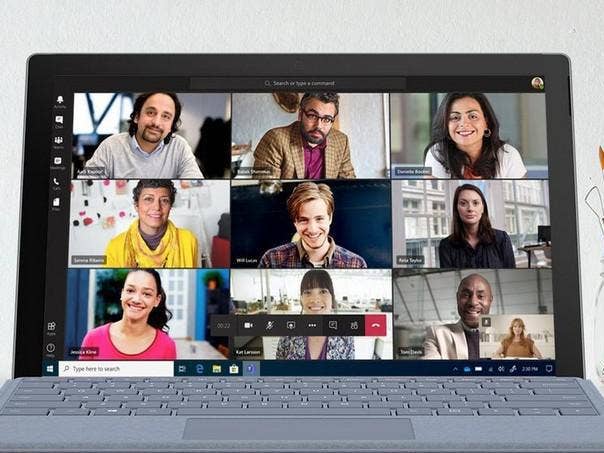
More Third-Party Apps For Teams
The killer app, of course, for Teams is the Teams app platform and how it has become the organizing layer for all applications you can use to run your business.
Just like mobile devices completely transformed how people consume software, we‘re seeing collaborative applications in Teams transform how people work together. Collaborative apps represent a paradigm shift on how apps are built. Instead of apps being the focal point where users go, collaborative apps bring business workflows, data and insights to where users are.
More than 1,600 third-party applications are available on Teams App Store today. And more than 100,000 companies have deployed their own custom line-of-business applications in Teams.
We‘ve seen leaders from every industry from Canva to ServiceNow build apps that deeply integrate Teams and Microsoft 365 across their workflows. 3M has built a Post-It app on Teams to support all the ways people brainstorm and collaborate, including taking notes on Post-Its.
Handwritten Post-It notes are seamlessly transformed into a digital whiteboard by simply taking a picture. Using the power of the graph, the app assigns tasks, surfaces relevant documents, automatically groups content and includes relevant notes, all within the Teams meeting experience.
SAP is building a Teams app so you can access and update real-time data from SAP’s S4/Hana Cloud directly inside a Teams chat.
And because the experience is built using Adaptive Card-based Loop components, the data can be shared in Outlook and stays in sync across SAP, Teams and Outlook, making it easy for employees to always have access to the latest information wherever they prefer to work. Adaptive Card-based Loop components will be generally available next year.
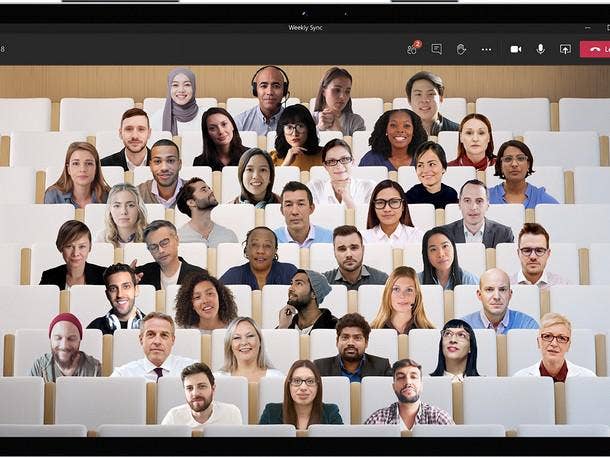
Bridging Physical Workplaces And The Metaverse
With Teams Rooms, you’re bringing teams to a growing ecosystem of devices and space configurations to help people stay connected and participate from anywhere. And I’m very excited to announce that Cisco will become a Microsoft Teams Rooms certified device partner and runs teams rooms or Android natively on their room systems.
The certified device portfolio will include multiple meeting devices and peripherals and more to come.
Our approach to space extends to the metaverse and how we’re bringing together the digital and physical worlds. We’re taking an approach to ensure that all our software can benefit users on all their favorite devices.
Our approach to space extends to the metaverse and how we‘re bringing together the digital and physical worlds. We’re taking an approach to ensure that all our software can benefit users on all their favorite devices. … We announced with (Facebook parent) Meta that we are bringing Teams immersive meeting experiences to (the) Quest (virtual reality device) so you can connect, share and collaborate in VR as though you are together in person. … I‘m thrilled to announce the private preview of Mesh avatars in Microsoft Teams globally.
Customers will be able to build their avatars in a way that reflects their identity and can represent them in meetings, giving them the flexibility and choice to be present without ever having to turn on a camera.
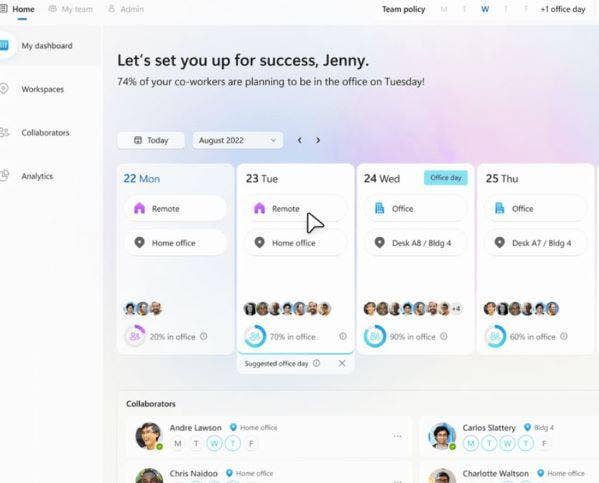
Microsoft Places Revealed
The hybrid workplace today is often too ad hoc. Leaders are being asked to rethink their real estate portfolio with very limited data, and employees are being asked to go into the office with very limited understanding of why they should come in in the first place.
That‘s why we’re introducing a new connected workplace category and announcing Microsoft Places. We want to help you turn your space into a place.
A space becomes a place when people give it meaning. Think about the importance of the Outlook calendar for orchestrating when people meet and collaborate. Places will do the same for where.
You don‘t just, say, show up for a meeting. You show up for purpose and connection. So we are building a new system to help you create a place, including tools to help you see when your colleagues are planning to come in, what meetings are best suited to be in person and reserve the right place for you. And for leaders, we provide recommendations on how to transform your space into a place.
Expanded Security For Windows
When it comes to Windows, we‘re fundamentally redesigning the operating system from the client to the cloud for hybrid work.
Windows 11 is designed for the future of work today, and from new PCs we announced just this morning to the expansion of our cloud offering from Windows 365 to Azure Virtual Desktop, Windows continues to evolve to work the way you do.
It starts by making you more secure with new cloud-powered features. Enhanced phishing protection helps you better understand whether something is malicious or clean. The combination of Windows Enterprise and Intune helps make your endpoints less vulnerable to evolving security threats.
And with Windows 365, we‘re transforming how you experience windows by bringing together the power of Windows computers with Azure computing. Windows 365 is a completely unique SaaS (software-as-a-service) offering built for this distributed workforce era. What this means is you can now access your cloud PC directly from Windows 11’s taskbar or start menu.
And we‘re also announcing the availability of Windows 365 Government and an enterprise multi-user plan designed for frontline and shift workers.
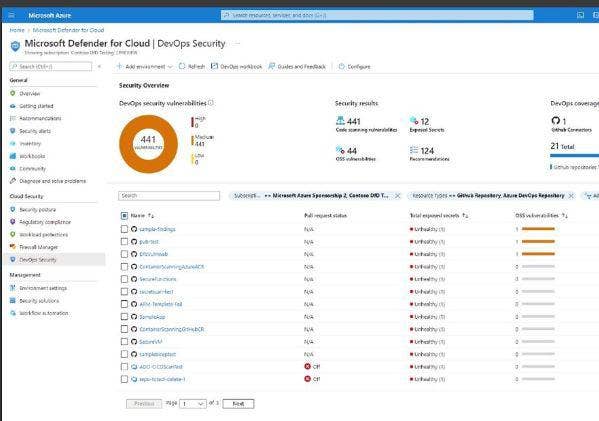
Introducing Defender for DevOps
For far too long, customers have been forced to adopt multiple disconnected (cybersecurity) solutions from disparate sources that don‘t integrate well and leave gaps. We offer a better option – a natively integrated security solution that is supported by a vibrant partner ecosystem.
It starts with Microsoft Entra, our new vision and portfolio for identity and access. It extends to Microsoft Purview … the future of compliance and data governance. As well as Microsoft Priva to help you manage privacy and Microsoft Intune to protect your endpoints and manage them. And, of course, Microsoft Defender and Sentinel.
You get a comprehensive solution that closes gaps and works for you at machine speed. On average, customers save more than 60 percent when they turn to us compared to a multi-vendor solution. Our approach extends to all clouds and all platforms. And we are investing to protect you. … We introduced new innovations in Defender for Cloud, including enhanced security posture management that‘ll help you focus on the most critical risks and provide built-in, multi-cloud security recommendations.
The new Defender for DevOps helps you secure the entire development lifecycle in a unified DevOps security management across multiple environments. We‘re also adding automatic attack disruption to Defender to limit lateral movement and help you stop ransomware before it gets a chance to encrypt your data.
And we are adding new identity governance capabilities to Entra, providing even greater control over digital identities across on-premises, the cloud, so that only the right people are granted the right access to the right resources at the right time, which is so critical in a world where everything is just one login away.